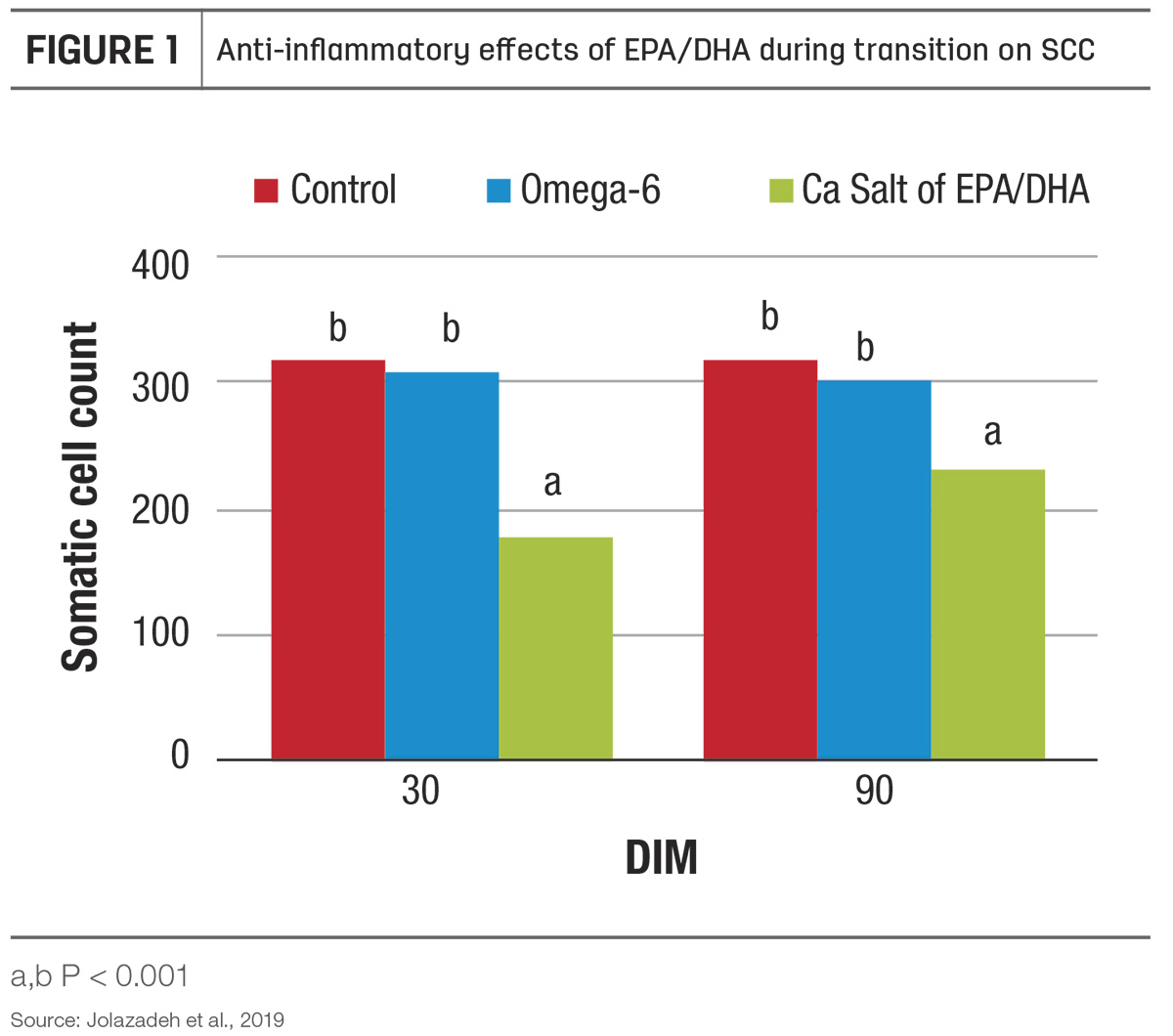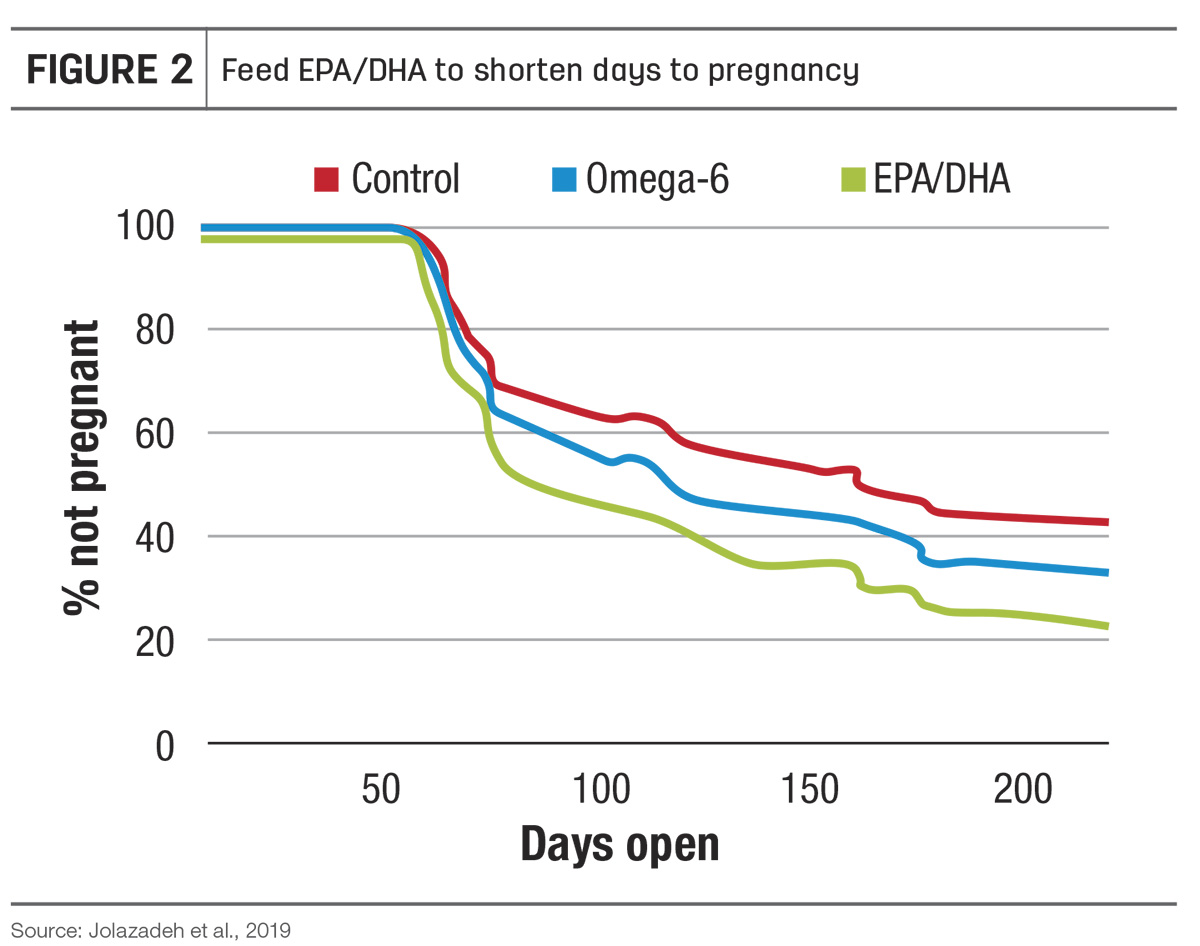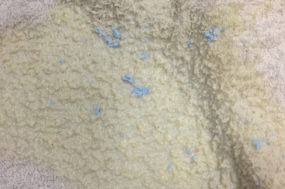If there is one set of research that has prompted me to think differently about how we manage dry cows, it is the work done by Dr. Geoffrey Dahl and team at the University of Florida on the effects of heat stress on dry cows. Their research over the past decade has shown that heat stress during the dry period can knock 10 pounds off of a cow’s next lactation performance. Not only is the heat-stressed dam’s milk production hindered, but the in-utero calf’s immune system is also compromised, resulting in less immunoglobulin G (IgG) absorption from colostrum and higher numbers not completing their first lactation. While cooling dry cows seems like a no-brainer, are there nutritional gaps in dry cow diets that, when filled, could have similar impacts on next-lactation performance and beyond?
One such case is with omega-3 fatty acids. While feeding supplemental fat is not a standard practice in close-up diets, these bioactive fatty acids are not "fat for energy." They are essential nutrients that should be looked at for their roles in cell signaling, immune modulation and metabolic function. While EPA/DHA omega-3 is known both for its role in healthy embryo development and retention, its effectiveness in resolving inflammation is just as important. It is this role in supporting a healthy immune response that has prompted new research to determine if EPA/DHA could be effective at reducing the cost of inflammation in the transition period and impact next-lactation performance.
As we walk through the recent research, you’ll notice there are several other types of omega fatty acids that are included besides EPA/DHA. So their characteristics are clear, here is a quick review:
- Omega-6, also called linoleic acid or 18:2, is very common in lactating diets as they are in everything corn-related: corn, distillers, corn silage, plus cottonseed and soybeans as well. They’ve long been recommended to supplement as a calcium salt in the close-up diets as they sit on the pro-inflammatory spectrum, helping the cow’s immune system to respond quickly to challenges during transition.
- ALA (linolenic or 18:3) is the plant-based omega-3 that needs to be converted to EPA/DHA for most of its biological activities regarding resolving inflammation and embryonic development. Most estimates show that conversion is very limited (less than one-half of a percent), leaving EPA/DHA inadequate in most diets.
Close-up only study on omega fatty acids
First, let’s look at some research that aimed at determining the effects of feeding close-up cows either calcium salts of EPA/DHA or omega-6. They looked at a wide range of results over the entire subsequent lactation, including colostrum quality, health disorders, reproduction and milk production. This study was unique in that the control group was no added fat in the close-up period, whereas most of the studies on EPA/DHA and omega-6s have been set up to be iso-energy and iso-lipid. Thus, the results versus the control group in this study result from a combination of more energy in the close-up diet, combined with the bioactivity of the omega fatty acids. Also, the subsequent lactation diets were the same for all cows, so the results measured are solely from the different treatments in the 21 days prior to calving.
Milk yield and quality effects
First, milk production was improved by both the EPA/DHA and the omega-6 treatment, with fat-corrected milk at 4 pounds higher versus control. Component yields were also higher in both treatments compared to the control cows, with higher fat yield over months four through 10 of lactation, along with higher protein yield across the entire lactation. Notably, the somatic cell counts (SCCs) were reduced in the EPA/DHA cows only compared to both the omega-6 and control treatments, with 100% lower SCC in the first month and 70% lower SCC over the first three months (Figure 1). Given the anti-inflammatory nature of EPA/DHA, these results make sense: More robust levels of EPA/DHA in the tissue will enable faster resolution of inflammation, thus lower SCCs.

Colostrum quality improved
Second, the quality improvements were also notable in the colostrum, with a higher concentration of IgGs from feeding either omega-6 or EPA/DHA versus no supplemental fat (126 versus 98 grams per liter). While the total volume of colostrum was unchanged, the fatty acid profile of the colostrum was altered with higher EPA/DHA and omega-6 showing up in colostrum from cows fed those treatments. (On a side note, the change in colostrum fatty acid profile is proof positive for the calcium salt effectively delivering these omega fatty acids past the rumen for greater absorption at the small intestine.) This shift in anti-inflammatory omega-3s in colostrum supports healthy immune response in the calf.
Earlier colostrum results have recently been repeated in a 2023 study with similar findings. In this follow-up study, a combination of EPA/DHA and ALA omega-3 were fed during the close-up period, resulting in higher levels of fat and protein, as well as increases in immune molecules (IgGs, lactoferrin and DHA) and fat-soluble vitamins in the colostrum.
Reproductive and health outcomes
Improvements were also seen across a number of reproductive measurements with both EPA/DHA and omega-6 treatments. Cows with supplemental omega treatments manifested heats six days earlier, were bred 10 days earlier and were open for 14 days less than control cows. In addition, the EPA/DHA cows had the greatest proportion of cows pregnant at 250 days in milk (DIM), although both omega treatments were significant versus control (Figure 2).

Regarding health outcomes, they no doubt followed what we’d expect given the results on improving reproduction. Cows fed either EPA/DHA or omega-6 had fewer reproductive disorders (including retained placentas, metritis, inactive ovaries and ovarian cysts), as well as fewer total health disorders (which include ketosis, mastitis and dystocia as well).
Greater ECM and liver function
While the study we just reviewed showed a wide range of impressive positive outcomes, it’s good to see studies with repetition. This next study from Cornell University fed EPA/DHA from 21 days prior to calving to 28 days post-calving, so the treatments were extended into the fresh period. While this study was aimed at better understanding the nutrient synergies between EPA/DHA and methionine in metabolic pathways and liver function, the results show greater ECM during the first four weeks after calving when fed adequate levels of EPA/DHA (+6.1 pounds ECM versus no added EPA/DHA) from pre-fresh to post-fresh (Figure 3). Greater liver function was also observed post-calving with adequate levels of both nutrients provided. EPA/DHA plays a role in helping export fatty acids from the liver to the mammary gland, reducing risk for fatty liver and improving insulin sensitivity in early lactation.

Improved heat stress resilience
Lastly, while the most recent research on EPA/DHA’s effectiveness in reducing heat stress effects was not a "dry cow" study, it is worth mentioning since (thanks to Dahl) we know the long-term consequences of heat stress during the dry period are tremendous. Work at CRSAD in Quebec has shown that EPA/DHA can be effective in partially alleviating heat stress, resulting in less elevated body temperatures and respiration rates, as well as more milk versus heat-stressed cows without EPA/DHA. In essence, EPA/DHA’s role in resolving inflammation helps to lessen the inflammatory response to heat stress which spares glucose from the immune system so that it can be redirected to the mammary gland.
Things to consider
Without a doubt, we know that the trajectory of a cow’s lactation is determined well before she calves. And the work by Dahl and the University of Florida on heat stress reminds us that it actually starts in utero. The recent body of research on EPA/DHA in close-up dry cows should cause us to stop and think about the amounts and profiles of fatty acids fed during that critical three-week period that not only sets up the cow’s next lactation but sets her offspring up on their future path.
Let’s remember that fatty acids are not only delivering needed energy to the cow during a time when intakes are dropping off. The role of fatty acids is far more complex. Omega fatty acids, particularly EPA/DHA, improve a wide array of both cow performance and colostrum measurements, when provided at adequate levels in close-up diets – thus, the reason they are deemed "essential." If you’ve been looking for a reason to revisit your "tried and true" close-up diet, digging deeper into fatty acids is a great one, with benefits that are extensive in the next lactation and perhaps for generations.
References omitted but are available upon request by sending an email to the editor.







